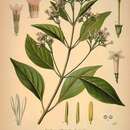Distribution
(
anglais
)
fourni par EOL authors
Native from mountains of northern Costa Rica to northeastern Venezuela and to Bolivia, from sea level to tree line but most of the species found in montane forests, above 1500 m elevation; and at least one species naturalized and weedy on some tropical islands.
Comprehensive Description
(
anglais
)
fourni par EOL authors
Small to large shrubs and trees, unarmed, terrestrial, without raphides in the tissues. Leaves opposite, petiolate, with tertiary and quaternary venation not lineolate, on the lower surface often with pubescent and/or foveolate domatia in the axils of the secondary veins; stipules quickly deciduous, interpetiolar or sometimes shortly fused around the stem, triangular to ligulate, generally held erect and flatly pressed together in bud. Inflorescence terminal and in axils of the uppermost leaves, thyrisiform to paniculiform, multiflowered, pedunculate, with bracts develed to reduced. Flowers sessile to pedicellate, distylous, protandrous, medium to large, fragrant, apparently diurnal; hypanthium ellipsoid to turbinate; calyx limb truncate short, 5-lobed, without calycophylls; corolla salverform, white to pink, purple, or red, densely pubescent internally in throat and on lobes, lobes 5, triangular, valvate in bud; stamens 5, inserted in corolla tube, with anthers narrowly ellipsoid, dorsifixed near base, included to partially exserted; ovary 2-locular, with ovules numerous in each locule, imbricated and ascending on axile placentas; stigmas 2-lobed, included or exserted. Fruit capsular, cylindrical to ellipsoid or ovoid, septicidally dehiscent from the base and/or sometimes from the apex, chartaceous to woody; seeds flattened, small, irregularly elliptic to oblong, marginally winged and often erose.
Brief Summary
(
anglais
)
fourni par EOL authors
The genus Cinchona includes at least 23 species of trees and shrubs that are native to the Andes of South America and the mountains of southern Central America. The trees have showy white, pink, or purple flowers that are generally pollinated by butterflies and hummingbirds, and dry capsular fruits with flat, papery seeds that disperse on the wind. Most of the species are found in Ecuador and Peru.
The bark of several species of Cinchona has been the source for several centuries of the febrifuge chemical quinine, effective against malaria. In the Andes the bark has been widely harvested from wild Cinchona trees, which has reduced their populations. Several species and numerous hybrids have been cultivated in warm humid regions world wide, particularly India and southeastern Asia.
Dispersal
(
anglais
)
fourni par EOL authors
The fruits are dry, rather woody capsules that open to release numerous small, papery, flattened seeds that are dispersed by the wind.
Reproduction
(
anglais
)
fourni par EOL authors
The flowers are diurnal, and white, pink, or purple and generally very hairy or fuzzy in the mouth of the corolla tube. They are apparently pollinated mainly by butterflies and hummingbirds. The flowers are distylous: some plants have only flowers of the long-styled ("pin" form), with the stigma positioned at the top of the corolla tube and the anthers positioned below, inside the tube; other plants have short-styled flowers ("thrum" form) with the reciprocal or opposite arrangement, with the anthers positioned at the top of the corolla tube and the stigmas below, inside the tube. This reciprocal arrangement is believed to promote out-crossing and diminish pollination by the same flower form, by depositing pollen on different parts of the pollinator so that the pollen from the short-styled flowers is transferred to the stigmas of the long-styled flowers, and vice versa. In general the distylous type of flower also has incompatibility at the cellular level, so the pollen of long-styled flowers generally has a very low success rate in other long-styled flowers, and vice versa.
Look Alikes
(
anglais
)
fourni par EOL authors
Cinchona has been confused with the very similar Rubiaceae genus Ladenbergia. In fact the separation of these was not clear for many years, but Andersson (1998) showed that species of Cinchona have white, pink, or purple flowers that open during the day and are hairy or fuzzy at the top of the tube and on the lobes, while Ladenbergia has bright white flowers that open during the night, and are not hairy or fuzzy at the top. Otherwise these two groups are difficult to separate. Previously they were sometimes separated by their fruits, which supposedly opened from the bottom in Cinchona vs. from the top in Ladenbergia, but Andersson showed that in fact this pattern of opening varies within both genera so this distinction does not actually work.

